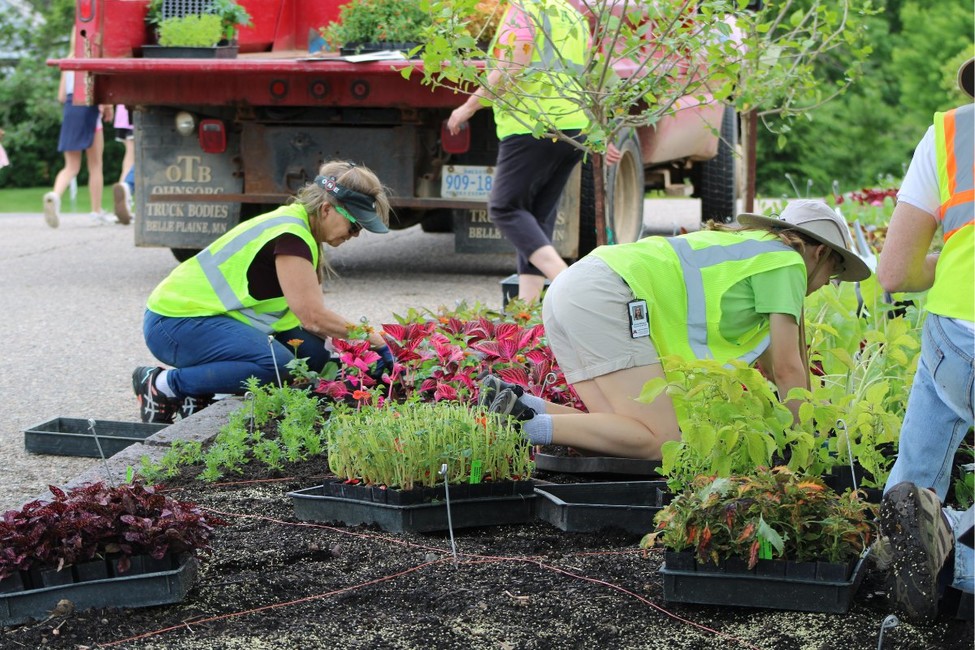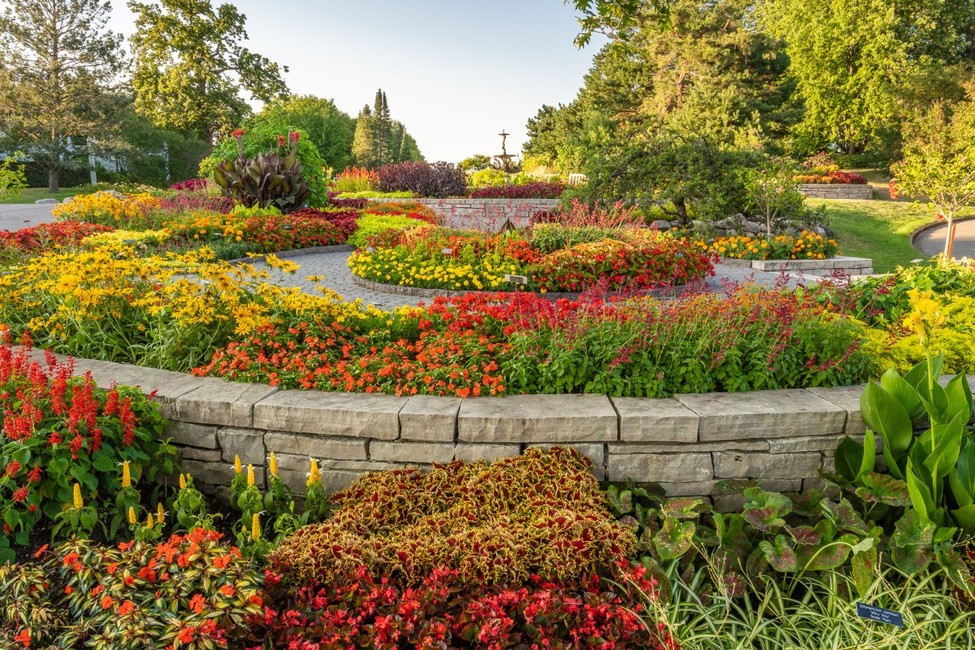In the spring at the Arboretum, 40,000 tulips illuminate the grounds, delighting visitors with their vast array of colors and flower forms in a stunning 135 unique varieties. By June, a new display begins to take shape in the Arboretum’s gardens, as the horticulture team plants the summer displays of annuals in the Annual Garden and beyond.
The Annual Garden steals the show in the summer months with bright and bold annuals playing the leading role. Photo by Todd Mulvihill
This year, gold-hued flowers celebrate the 50th anniversary — or golden anniversary — of the Arboretum’s historic Snyder Building, named for the Arboretum’s first director, Leon C. Snyder. Opened to the public in 1974, the building served as the Arboretum’s first visitor center and was designed by architect Edwin Lundie.
Replacing the orderly swaths of springtime tulips, the summer displays of annuals let loose a riot of texture, pattern and color in the Arboretum’s gardens.
Designed in the same gold-inspired color palette, the plantings around the Snyder Building will feature a blend of bold flowering annuals such as cannas, celosia and marigolds alongside plants prized for their foliage, including several varieties of leafy coleus in vivid orange and yellow.
In early summer, staff and volunteers plant annuals across the gardens of the Arboretum, including the main display in the Annual Garden. Photo by Lily Smith
In the annual displays farther away from the Snyder Building, the gold color palette is infused with shades, tints and tones of red, echoing the displays of tulips in the spring Annual Garden and the main entrance beds along Highway 5 and the Gatehouse.
Horticulturist Duane Otto designs the displays of summer annuals and begins the planning and design process in the summer of the preceding year. Plants are carefully selected and mapped out based on considerations including height, color, texture, summer resiliency and novelty appeal. A majority of the plants are grown at the Arboretum by Greenhouse Manager Ricky Garza and Arboretum staff, and are planted by staff and volunteers in early June.
This year, Otto has included the whimsical popcorn plant in his designs, aptly named for its popcorn-like scent and buttery yellow flowers. “It’s different, unique,” said Otto, “People like it for the fragrance.”
Horticulturist Duanne Otto has designed the annual displays for more than 35 years. Photo by Johanna DeBuhr
Tropical canna lily and elephant ear colocasia add height and color to the back of the borders in the Annual Garden. Keep an eye out for canna ‘Richard Wallace’ in a gorgeous sunshine yellow as well as colocasia Royal Hawaiian® 'Maui Gold' which features broad chartreuse leaves.
Foliage plants such as colocasia and coleus play a large part in Otto’s designs. “Coleus varieties provide instant color because their foliage is colorful and they do well in our hot summers here,” said Otto. “You don’t always need flowers to provide color, and flowers need maintenance like deadheading."
Visitors can expect to see the bright blooms of canna lily alongside the impressive foliage of colocasia in the Annual Garden. Photos by Don Olson (left) and Julie Peters
For Otto, who has designed the Arboretum’s annual displays for more than 35 years, it’s all about delighting Arboretum visitors with bold designs, inspiring color palettes and new and exciting plant varieties — paired with some old favorites. The gardens also play a special role for two important after-hours Arboretum events as they serve as a backdrop for both the Gala in the Gardens fundraiser in June and the Taste & Toast food-and-drink party in July.
Visit the Arboretum all summer long to view the displays of summer annuals in the Annual Garden and around the Oswald Visitor Center and Snyder Building.
More than 30 years of Otto’s garden designs are archived at the Andersen Horticultural Library and at z.umn.edu/ArbGardenPlans.
Sunset washes over the Annual Garden. Photo by Jason Boudreau-Landis
Cover photo by Jason Boudreau-Landis





